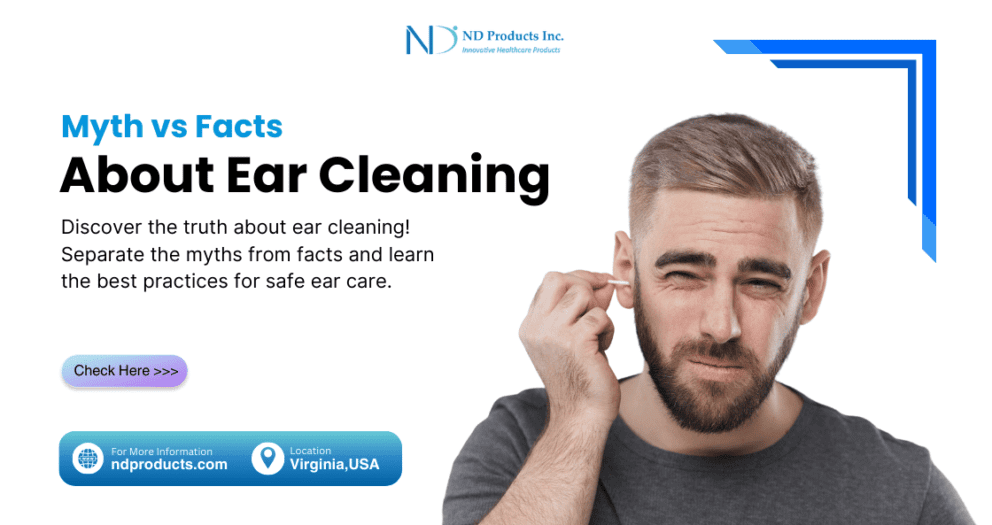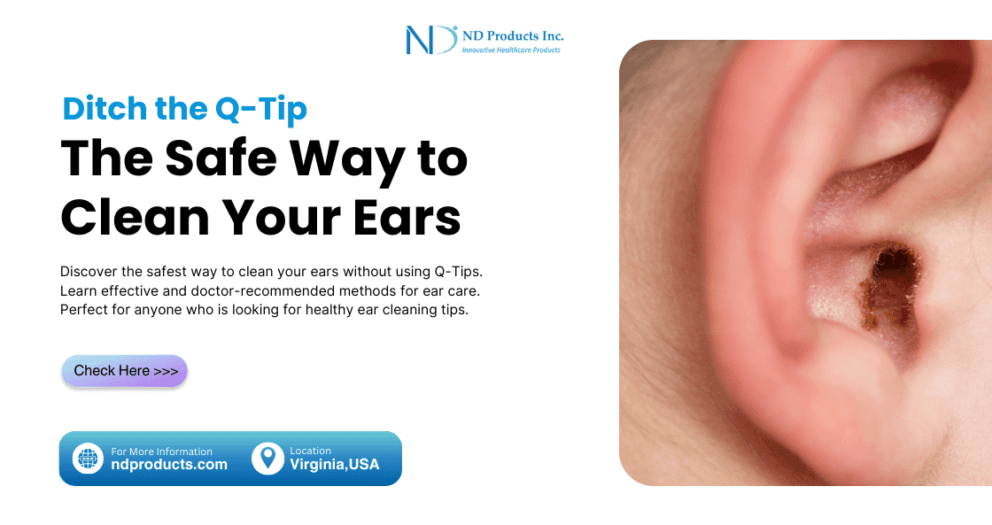Taking care of your ears is crucial for maintaining a healthy ear and hearing. One essential aspect of ear care is safe and proper ear cleaning, but many people are unsure about when, why, and how to clean their ears properly. In this comprehensive guide, we’ll delve into the importance of ear cleaning, discuss the when and why, and provide you with essential tips on how to do it effectively. Plus, we’ll introduce you to ND Products Inc, your go-to source for high-quality ear cleaning solutions.
Understanding Ear Wax
Let’s start by addressing the elephant in the room: ear wax. Also known as cerumen, ear wax is a natural substance produced by the glands in the ear canal. Contrary to popular belief, ear wax is not a sign of poor hygiene. In fact, it plays a vital role in protecting the ear canal from dust, dirt, and other foreign particles. Additionally, ear wax has antibacterial properties that help prevent ear infections.
What Color of Your Ear Wax?
Earwax can vary in color and consistency, influenced by factors such as genetics, age, diet, and overall health.
While the color of earwax is typically shades of yellow or brown, it can also appear in other hues, ranging from light tan to dark brown. The variation in color is primarily due to the presence of melanin, a pigment found in the skin, as well as the accumulation of dirt, dead skin cells, and other debris.
Some individuals may have earwax that is lighter in color, resembling a pale yellow or beige, while others may produce earwax that is darker, resembling a deep brown or even black.
Additionally, the consistency of earwax can vary from soft and moist to dry and flaky, depending on factors such as hydration levels and the activity of the ceruminous glands.
While the color and consistency of earwax can vary among individuals, it is important to note that earwax is generally considered normal and healthy.
However, excessive buildup of earwax, known as cerumen impaction, can lead to symptoms such as earache, hearing loss, itching, and discomfort. In such cases, it may be necessary to remove the excess earwax using methods such as earwax removal kit or removal by a healthcare professional.
When to Clean Your Ears
While ear wax serves a protective function, excessive buildup can lead to discomfort and even hearing problems. So, when should you clean your ears? The answer varies from person to person. Some individuals naturally produce more ear wax than others and may need to clean their ears more frequently. However, as a general rule of thumb, you should consider cleaning your ears if you experience:
- Earache or discomfort
- Reduced hearing
- Itchiness or irritation in the ear canal
- Visible ear wax buildup
Why Clean Your Ears
Beyond addressing discomfort and hearing issues, there are several other reasons why regular ear cleaning is essential:
- Prevention of Infections: Removing excess ear wax can reduce the risk of ear infections, particularly in individuals prone to recurrent infections.
- Improved Hearing: Excessive ear wax buildup can block the ear canal, leading to temporary hearing loss. By cleaning your ears, you can maintain optimal hearing health.
- Enhanced Comfort: Cleaning your ears can alleviate itchiness, irritation, and discomfort caused by ear wax buildup.
- Facilitates Examination: For individuals who wear hearing aids or undergo ear examinations, clean ears provide a clearer view of the ear canal and eardrum.
How to Clean Your Ears Safely
Now that we’ve covered the when and why let’s discuss the all-important how. Proper ear cleaning involves gentle techniques to avoid damaging the delicate structures of the ear. Here’s a step-by-step guide to cleaning your ears safely:
- Use Eardrops: If you have a hard earwax begin by softening the ear wax with over-the-counter ear drops or olive oil. Administer the drops according to the instructions on the packaging allow them to sit in your ear for a few minutes.
- Irrigation: After the ear drops have softened the wax, you can irrigate the ear canal with warm water. Tilt your head to the side and gently squeeze a bulb syringe or use a specialized ear irrigation kit to flush out the loosened ear wax. Ensure that the water is at body temperature to prevent dizziness or discomfort.
- Avoid Q-Tips: Despite their widespread use, cotton swabs or Q-tips are not recommended for ear cleaning. They can push ear wax deeper into the ear canal, leading to impaction or injury to the eardrum.
- Seek Professional Help: If your earwax is already pushed deeper by finger, swab or other means, consult a healthcare professional. A doctor or an ENT specialist can perform ear irrigation or ear wax removal using specialized tools and techniques.
Introducing ND Products Inc
At ND Products Inc, we understand the importance of ear health and offer a range of innovative solutions to support your ear care routine. Our products are designed with safety, effectiveness, and user comfort in mind, providing you with peace of mind and optimal ear hygiene.
Our ear wax removal kit are gentle yet effective, helping you maintain clear and healthy ears without the need for harsh chemicals or invasive procedures.
Conclusion
In conclusion, ear cleaning is an essential aspect of ear care that can help prevent discomfort, hearing problems, and ear infections. By understanding when, why, and how to clean your ears properly, you can maintain optimal ear health and enjoy clear hearing. choose safe and effective ear-cleaning products such as the new all-in-one patented compact earwax removal kit offered by ND Products Inc to support your ear care routine. Here’s to happy and healthy ears!






Hi there! This is my first visit to your blog!
We are a group of volunteers and starting a new initiative in a community
in the same niche. Your blog provided us useful information to work on. You have done a wonderful job!